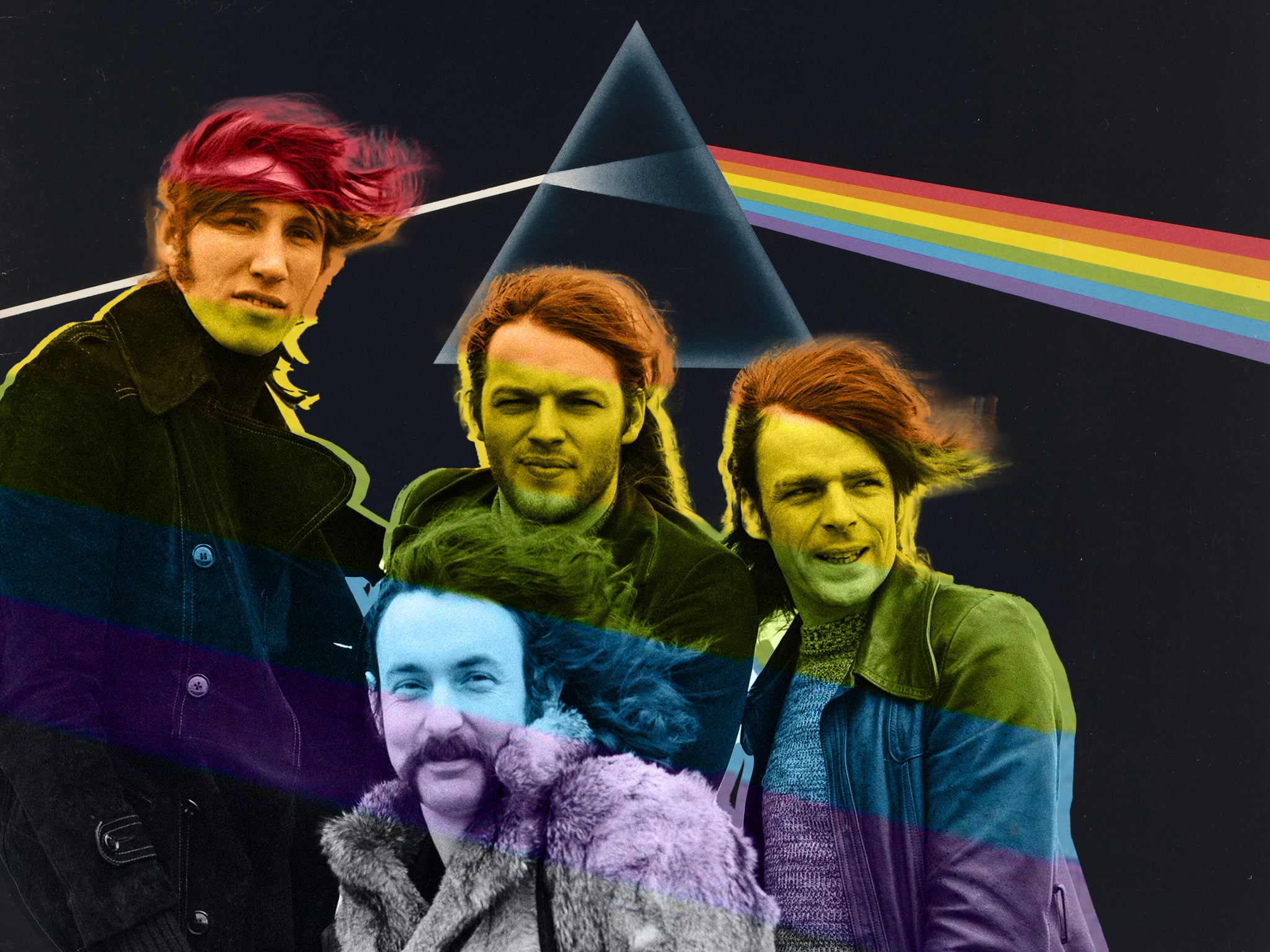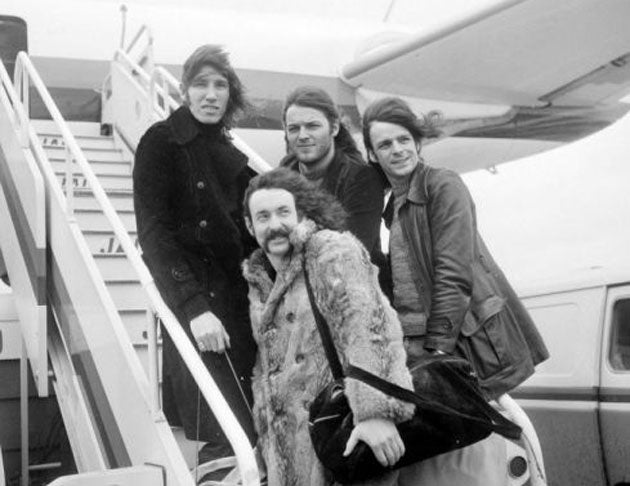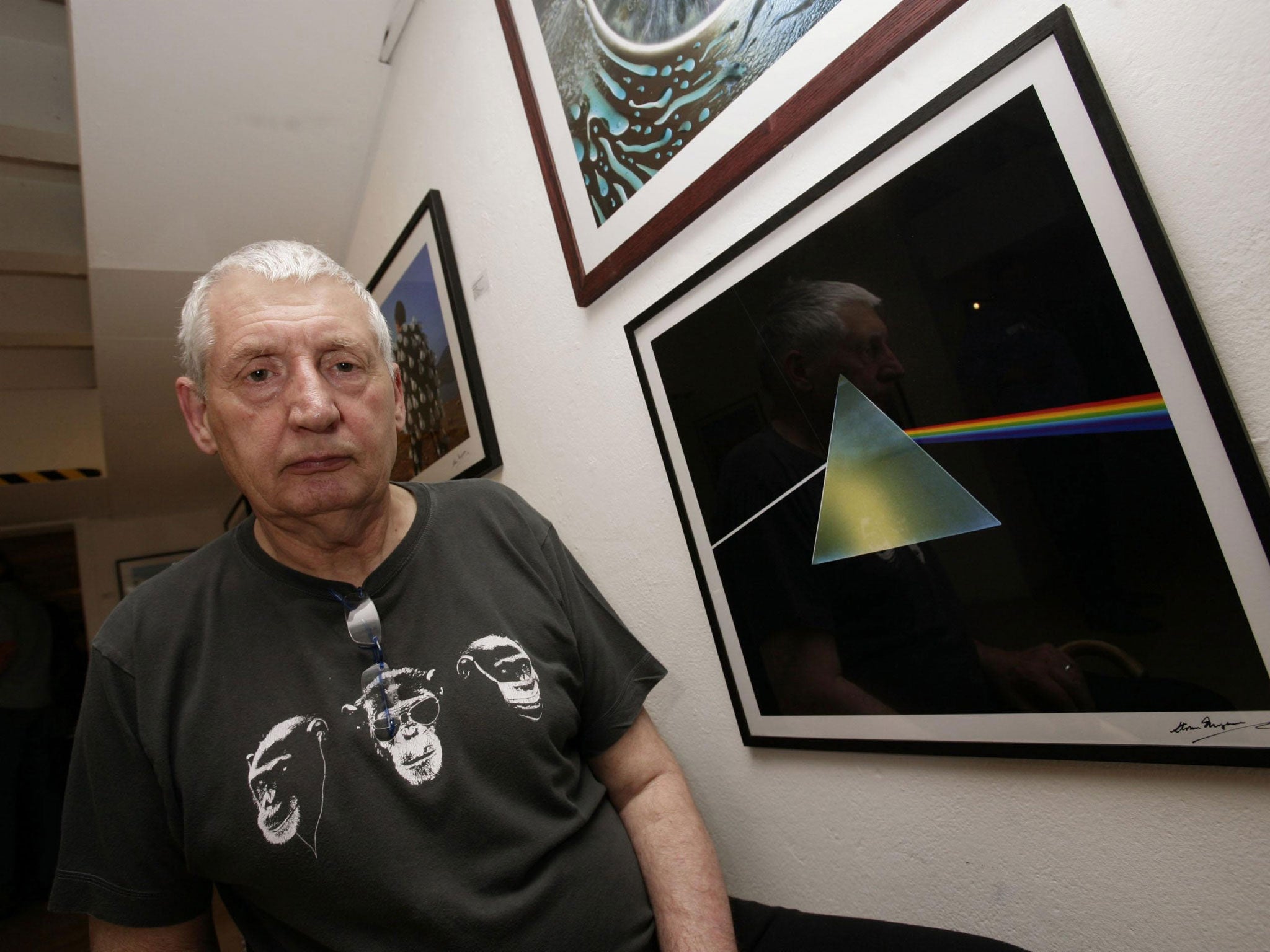‘Sublime menace and sonic enormity’: Pink Floyd’s The Dark Side of the Moon at 50
Mark Beaumont explores how melodic brilliance and psychedelic innovation came together to create a monolith of British rock music

On 1 March 1973, a new moon rose over rock music. Immersive, quadrophonic, celestial and deeply introspective, Pink Floyd’s eighth album arrived in a heady flurry of cash tills, chiming clocks, pained-angel arias and cold, disembodied voices speaking of violence, death and insanity. Where their prog-rock peers were busy crafting grandiose yet chintzy pantomimes of Arthurian legend, sci-fi fantasy and messianic pinball, the Floyd delved into the dark universe of humanity’s inner space; into the stresses and horrors of everyday life that daily push us all to the brink. A record as relatable as it was cosmic, as melodic on the topics of “Time” and “Money” as it was climactic on the themes of war, division and madness, The Dark Side of the Moon set a new standard for high-concept intellectual rock. Forty-five million prism-clad units later, it remains the fourth best-selling record ever made.
Fifty years on, we seem to have crash landed on the dark side of Pink Floyd themselves. For decades, the simmering resentments between the band’s main players Roger Waters and David Gilmour have played out in frank and pointed barbs quietly doled out to interviewers. Almost 40 years after his 1985 departure from the band, Waters remains incredulous that his uninspired ex-bandmates managed to keep a “faux Floyd” going without his (admittedly dominant) concepts and songwriting, releasing albums he deems unworthy of the name and painting him as “autocratic”. Gilmour, though generally reticent about beating Waters’ High Court suit to dissolve the band in 1986, still bristles at the bassist’s powermonger attempts to claim full credit for the band’s monumental 1970s achievements.
On the surface, the beef has seemed straightforward and surmountable enough for Pink Floyd to reunite for three songs at Live 8 in 2005, and the cutthroat edges of their public digs were generally tempered by an inherent Cambridge-bred civility. Until now. Last month, Gilmour’s wife Polly Samson, who had come under fire from Waters for her lyrical contributions to The Division Bell, posted a tweet accusing him of being “antisemitic to your rotten core…a Putin apologist and a lying, thieving, hypocritical, tax-avoiding, lip-synching, misogynistic, sick-with-envy, megalomaniac”. Gilmour retweeted the post, adding “Every word demonstrably true”.
Waters – a long-term critic of the Israeli government’s “genocide” and “apartheid” against the Palestinian people, who had criticised Pink Floyd for recording a protest song with Ukrainian musician Andriy Khlyvnyuk last year and described Putin’s invasion of Ukraine as “illegal” but “not unprovoked” in a recent address to the UN Security Council – responded with a statement refuting Samson’s accusations as “incendiary and wildly inaccurate”. In the crossfire, a detail of Waters’ recent Floyd revisionism almost passed by unnoticed.
In an interview with the Telegraph peppered with attacks on his ex-bandmates (“They have no ideas, not a single one between them… and that drives them crazy”), he revealed that he has re-recorded Dark Side… in its entirety from scratch, without their knowledge or permission. The re-recorded version, initially set to be released around the same time as a 50th-anniversary reissue of Dark Side…, sounds dramatically revised. “Money” is now a “country-tinged” piece not dissimilar to Johnny Cash, and instrumental tracks such as “On the Run” now feature Waters reciting prose poetry over the top to help assuage his frustration that “not enough people recognised what it’s about, what it was I was saying then”. “I wrote The Dark Side of the Moon,” he attested, “Let’s get rid of all this ‘we’ crap! Of course we were a band, there were four of us, we all contributed – but it’s my project and I wrote it.”
For Floyd purists, Waters remaking a masterpiece like Dark Side… will seem akin to Monet repainting his Water Lilies because he’d fallen out with the colour blue. Few albums are considered so untouchably perfect and complete, from “Speak to Me”, with its collage of babbling voices, cash registers, manic laughter and muted heartbeats, to the sunburst crescendo at the climax of “Brain Damage/Eclipse”. And it’s become iconic, too, as historic proof that hazy visions ultimately crystallize, great talents cohere and important art inevitably triumphs.
In the wake of the loss of their enigmatic frontman Syd Barrett to suspected drug-induced schizophrenia in 1968, Pink Floyd entered a period of somewhat restless sonic questing. For three years, they attempted to morph the psychedelic possibilities of their 1967 debut album Piper at the Gates of Dawn into something the band, and music in general, wasn’t quite ready for yet. Over albums such as A Saucerful of Secrets (1968), Ummagumma (1969) and Atom Heart Mother (1970) they delved ever-deeper into the sort of lengthy, multi-part musical journey they’d initiated with the 10-minute “Interstellar Overdrive” at their early shows. Experimenting with avant-garde orchestral stretches and found sounds – dripping taps, or their roadie eating toast – tracks like “Atom Heart Mother”, “Sysyphus” and “Alan’s Psychedelic Breakfast” dominated entire sides of their albums, helping to instigate prog rock’s definitive trait: the “transportive song-cycle”.

Such weirdness earned them a devoted cult following of stoned hippies sitting on the floor of their ballroom gigs in astral reveries. But their ambitions in long-form sonic odyssey only really came together when the dreamy and dramatic “Echoes” took up side two of 1971’s Meddle album. Borrowing imagery from 19th-century Romantic poet Samuel Taylor Coleridge and John Lennon’s “Across the Universe” and building from a series of quiet sonar pings into a powerful tribute to human connection, “Echoes” was a tour de force of mustering dynamics and a 23-minute eureka moment. Tiring of playing their established material and realising that their moment of alchemy was finally upon them, Pink Floyd next envisaged an entire album-length suite of music united by a single theme.
According to Waters, the concept for The Dark Side of the Moon – initially titled Eclipse: A Piece for Assorted Lunatics, since the Dark Side… title was already being used for a Medicine Head album – was in place before much of the music or lyrics were written. At a 1971 meeting in the kitchen of drummer Nick Mason’s Camden home, Waters proposed that, for their forthcoming tour, they write and perform an entire album based on what he’d describe as “the pressures and preoccupations that divert us from our potential for positive action”. Gilmour would summarise it as “the pressures of modern living… that conspire to send some people insane”.
The strains of being an often-homesick touring rock band sneering enviously at the “hi-fidelity first-class travelling set” weren’t far from their minds, nor the fate of Syd Barrett. It was a memory of their former singer trespassing on a riverside lawn in Cambridge which would inspire Waters to pen the line “the lunatic is on the grass” for “Brain Damage”, and Syd’s subsequent mental decline that inspired the song’s tragic anti-hero. A character whose “dam breaks open many years too soon”, whose “head explodes with dark forebodings” and who ultimately finds themselves cut off from their own enclosed world. “And if the band you’re in starts playing different tunes,” Waters would sing, “I’ll see you on the dark side of the moon”.
That iconic title phrase, Waters later explained, was his attempt to reach out to his struggling listeners. “If you feel that you’re the only one,” he later explained, “that you seem crazy ’cause you think everything is crazy, you’re not alone.”
Here lads, I’ve written the ending
By jamming relentlessly in tour rehearsals and working up lingering or rejected material from what Waters called “the rubbish library” – instrumental compositions by keyboardist Rick Wright called “The Violent Sequence”, “Religious Theme” and “The Travel Section” – the Floyd built a rough yet gliding framework for the piece, based around rudimentary versions of “Breathe”, “The Great Gig in the Sky”, “On the Run” and “Us and Them”. To this, Waters added funk-infused garden shed demos of consumerist satire “Money” and grab-life-while-you-can edict “Time”, and the formative Eclipse project evolved further on tour. Audiences at the album’s earliest UK performances in January and February 1972 found the band wrestling with the technical challenges of their pioneering new quadrophonic sound system and smothering “The Great Gig in the Sky” with recordings of Malcolm Muggeridge monologues and spoken-word readings from St Paul’s epistle to the Ephesians. After a day off in Bristol, however, Waters arrived at the following night’s show with an entire, brilliantly climactic new song called “Eclipse”, declaring, “Here lads, I’ve written the ending.”
The Dark Side of the Moon, as it was eventually titled when Medicine Head’s album sank without trace, was premiered to an awestruck press at London’s Rainbow Theatre on 17 February. “The ambition of the Floyd’s artistic invention is now vast,” wrote The Sunday Times. Honing and expanding the work over the following months, Floyd arrived at Abbey Road with the album virtually complete and ready to record, bar some key atmospheric additions echoing The Beatles’ use of Abbey Road as one big experimental laboratory of sound.
A Synthi A synthesizer was fired up to add compulsive electronic momentum to “On the Run” and “Time”. The cash register noises on “Money” were pieced together from Abbey Road sound-effects records, recordings of Waters throwing coins into his wife’s industrial food mixer and the sound of the band dropping bags of cash onto the studio floor from six feet up. The cascade of chiming clocks was originally recorded timepiece by piece in an antique clock shop by engineer Alan Parsons to showcase the effects of quadrophonic sound, and purloined by the Floyd to open “Time”. A group of backing singers – Doris Troy, Lesley Duncan, Liza Strike and Barry St John – arrived to add gospel largesse to tracks including “Brain Damage” and “Us and Them”, noting the very reserved and unforthcoming nature of a band making an album supposedly espousing human connection and empathy. “They weren’t very friendly,” Duncan would recall, “they were cold, rather clinical… The most we got was ‘that’ll do’.”
Pink Floyd weren’t very friendly... the most we got was ‘that’ll do’
To flesh out the album’s theme, Waters began interviewing people – roadies, engineers, anyone he could grab around the studio – using a fixed set of question cards: “When was the last time you were violent?” “Were you in the right?” “Are you frightened of dying?” “Do you think you’re going mad?” Recording Wings’s Red Rose Speedway in the next-door studio, Paul McCartney took part, although his answers were deemed too performative and humorous to include – “too clever, too guarded,” Gilmour said, “he didn’t want to give anything away.” Wings guitarist Henry McCullough, however, did contribute the line “I don’t know, I was really drunk at the time”.
Dispersed amongst the cosmic spaciousness of the record, the interviews became a kind of internal monologue of the album, the voices in the head of the album that seemed to drift out from the dark side of the moon itself. The manic laughter of road manager Peter Watts, father of film actor Naomi. The road rage altercation described by roadie Roger “The Hat” Manifold. And Abbey Road doorman Gerry O’Driscoll delivering the album’s most calmly philosophical sentiments: “I am not frightened of dying. Any time will do, I don’t mind”, “I’ve always been mad… like most of us have” and “there is no dark side in the moon, really. As a matter of fact it’s all dark”.
Just as pivotal, though, was the arrival of 25-year-old session singer Clare Torry, paid £30 to add vocals to “The Great Gig in the Sky” to replace the Biblical voices. “We wanted to put a girl on there, screaming orgasmically,” Gilmour would explain, and it took Torry a few takes to get the full elemental flow of what they wanted. “She had to be told not to sing any words,” Parsons said. “When she first started, she was doing ‘Oh yeah baby’ and all that kind of stuff, so she had to be restrained on that. But there was no real direction – she just had to feel it.” “They said, ‘Try some longer notes’, so I started doing that,” Torry remembered. “That was when I thought, ‘Maybe I should just pretend I’m an instrument.’”
Torry herself initially considered the resulting improvised, one-take vocal as “screechy-screechy… caterwauling” and, met with the band’s characteristic reserve, cut short a second vocal take for sounding contrived and exited the studio a little embarrassed, convinced her performance would never make the album. Yet it stands amongst the greatest vocals ever recorded: a self-contained universe of wordless emotion, by turns proud, impassioned, ecstatic, feverish, desperate, seductive, terrified and broken. “She was fantastic,” Gilmour said and, following a 2004 royalties’ suit, Torry would receive a co-writing credit for her vital contribution to one of the best and biggest-selling albums of all time, and see her £30 fee bumped up considerably by an out-of-court settlement.
On release, The Dark Side of the Moon swiftly became a titan of 1970s rock music. Waters remembered playing the finished album to his wife and her “bursting into tears when it was finished… I thought, ‘This has obviously struck a chord somewhere.’” The chord it struck was global: the album swiftly ascended to the top of the US chart and, although only reaching No 2 in 1973, would spend 555 weeks in the UK Top 100 to date as it gradually racked up 45 million worldwide sales.

The record’s monumental success placed it at the very heart of 1970s counterculture, a monolith of British rock to rank alongside Sgt Pepper and Led Zeppelin IV and grand testament to the surgical introspection, sublime menace and sonic enormity of which our musical psyche was capable. Here was a record which upheld and epitomised the melodic brilliance and psychedelic innovation of the UK’s music sphere in the Sixties and early Seventies, while simultaneously exposing the stress, division, dislocation and inhumanity at the core of its so-called polite and civilised society.
For the burgeoning progressive rock scene, it became both culmination and aspiration: a musically and thematically unified record relatable enough to entrance millions, yet magical enough to provoke dopehead rumours that it was designed to match up scene-by-scene with The Wizard of Oz. But for Pink Floyd themselves, it was the beginning of the end. Reaching stadium level in America to find their respectful, attentive audience had been replaced by drunken whoopers shouting for “Money”, they found themselves on the horns of the timeless rock phenomenon’s dilemma: once you’ve achieved everything you set out to achieve, what then? “The Dark Side of the Moon finished off Pink Floyd once and for all,” Waters once said, “To be that successful is the aim of every group. And once you’ve cracked it, it’s all over.”
Sessions for the follow-up, 1975’s Wish You Were Here, were notoriously aimless, disjointed and despondent, and subsequent albums would increasingly become vehicles for Waters’ songs and concepts tackling alienation, socio-political oppression and personal trauma, peaking with 1979’s 30 million selling, semi-autobiographical magnum opus The Wall.
The seeds of Pink Floyd’s current frictions, then, can be traced back to their pinpoint-perfect Moon landing. But with an estimated 10,000 copies selling every week right up until the streaming era, The Dark Side of the Moon is still connecting with new generations feeling time slipping away, hanging on in quiet desperation and far from immune to the stresses of wage slavery, poverty, war paranoia and crises of the self.
“I think it says ‘it’s OK to engage in the difficult task of discovering your own identity, and it’s okay to think things out for yourself’,” Waters has said of the record’s enduring appeal, and late-stage capitalism has undoubtedly kept Dark Side… relevant. “Us and Them” could be a premonition of today’s cost of living crisis and social inequality (“With, without, and who’ll deny it’s what the fighting’s all about?”; “For want of the price of tea and a slice, the old man died”), while the record holds a wisdom we’d be well-advised to heed in such uphill times. “Long you live and high you fly,” Gilmour sings on “Breathe”, “but only if you ride the tide”.
Join our commenting forum
Join thought-provoking conversations, follow other Independent readers and see their replies
Comments


Bookmark popover
Removed from bookmarks